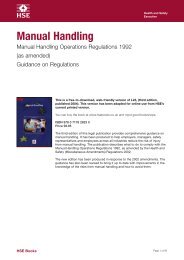Making Companies Safe - what works? (CCA ... - Unite the Union
Making Companies Safe - what works? (CCA ... - Unite the Union
Making Companies Safe - what works? (CCA ... - Unite the Union
You also want an ePaper? Increase the reach of your titles
YUMPU automatically turns print PDFs into web optimized ePapers that Google loves.
effectiveness of safety representatives is compromised by <strong>the</strong> fact that employers are free to<br />
disregard <strong>the</strong>ir advice or warnings. 12 <strong>Safe</strong>ty representatives in Australia also have a legal right<br />
to ‘stop <strong>the</strong> job’ (prohibit work) in circumstances where <strong>the</strong>y identify serious and imminent<br />
dangers. 13 The HSE review concluded that:<br />
“There can be no doubt as to <strong>the</strong> positive contribution of OHS [representative]<br />
enforcement – ie PINs and work stoppages. This is evidently <strong>the</strong> view held by<br />
Work<strong>Safe</strong> Victoria, demonstrated by <strong>the</strong>ir endeavours to improve OHS rep<br />
support and dedicate considerable funding solely to an OHS rep strategy. Their<br />
current commitment stands out as confirmation that <strong>the</strong>y support regulated<br />
worker empowerment… Australian reps are better placed than <strong>the</strong>ir UK<br />
counterparts, to overcome health and safety non-compliance in <strong>the</strong>ir workplaces.<br />
This has to be beneficial to <strong>the</strong> health, safety and well-being of Australian<br />
workforces… PINs and o<strong>the</strong>r OHS rep sanctions, supported by issue resolution<br />
legislation, appear to have much to offer <strong>the</strong> UK system of worker<br />
participation.” 14<br />
However, in 2000, before <strong>the</strong> results of <strong>the</strong> HSE review had been published <strong>the</strong> HSC/E<br />
had virtually ruled out <strong>the</strong> possibility of introducing regulations that would allow worker<br />
representatives to issue PINs, 15 instead stating that <strong>the</strong>y would investigate <strong>the</strong> feasibility of<br />
supporting non-statutory ‘<strong>Union</strong> Improvement Notices’. This was on <strong>the</strong> basis of <strong>the</strong>ir belief<br />
that PINS might be ‘bureaucratic’, ‘difficult to match with <strong>the</strong> modern partnership approach’,<br />
and ‘resource intensive’. 16 These beliefs are contradicted by <strong>the</strong> HSE review, which found that<br />
PINs actually offered potential benefits to <strong>the</strong> HSE in terms of <strong>the</strong> efficient use of regulatory<br />
resources since:<br />
“The rep sanctions appear to provide genuine opportunities for workplaces to<br />
manage health and safety internally, without recourse to HSE, freeing up HSE to<br />
concentrate on proactive initiatives and <strong>the</strong> enforcement of recalcitrant<br />
employers. And <strong>the</strong> issue of resolution arrangements provide HSE with <strong>the</strong><br />
option of becoming involved only when a health and safety dispute arises and<br />
issue resolution measures are exhausted, ie when internal negotiation fails.” 17<br />
Moreover, <strong>the</strong> review provided strong evidence that employers’ fears that safety<br />
representatives would ‘misuse’ PINS were misplaced. Australian regulators and trade union<br />
representatives maintained that PINs were used sparingly and as a last resort – a view which<br />
was not challenged by any of <strong>the</strong> employer or trade association representatives <strong>the</strong> researcher<br />
met. 18 Confirmation of this anecdotal evidence was found in <strong>the</strong> fact that during <strong>the</strong> State of<br />
Victoria’s health and safety week (when OHS would be expected to attract a particularly high<br />
profile) Work<strong>Safe</strong> staff were alerted to 98 PINs. All but nine of <strong>the</strong>se were affirmed – and<br />
those nine were cancelled for failures to consult. 19<br />
Despite such reassurances, this new and favourable assessment of <strong>the</strong> impact of PINs did not<br />
appear to prompt a rethink on <strong>the</strong> part of <strong>the</strong> HSC/E. This may have been because <strong>the</strong> HSC/E<br />
were hoping that provisions in <strong>the</strong> draft harmonised Regulations, which imposed a new duty<br />
on employers to respond to safety representatives’ concerns, might address <strong>the</strong> problem<br />
in <strong>the</strong>ir advice and warnings being ignored. However, at an HSC Board meeting on 11<br />
November 2003, <strong>the</strong> Commission agreed a statement declaring support for greater workforce<br />
involvement in health and safety, but this statement was:<br />
“founded on <strong>the</strong> belief that it would be better to concentrate efforts on nonregulatory<br />
measures to take forward <strong>the</strong> goal.” 20<br />
It is not clear why <strong>the</strong> Commission chose to adopt this approach, or whe<strong>the</strong>r <strong>the</strong> HSC/E have<br />
completely abandoned <strong>the</strong>ir intentions to introduce new regulations that would harmonise<br />
<strong>the</strong> 1977 and 1996 Regulations. The Commission assert in <strong>the</strong>ir November meeting that:<br />
“While <strong>the</strong> statement could make <strong>the</strong> case for legislation <strong>the</strong>re remained strong<br />
arguments for non-regulatory measures too.” 21<br />
30<br />
Although <strong>the</strong> Commission failed to specify <strong>what</strong> those arguments were, it may have been<br />
influenced by <strong>the</strong> fact that some Government Departments had expressed concerns that <strong>the</strong><br />
draft proposals were:
















